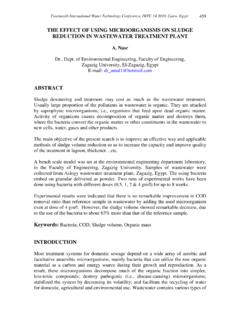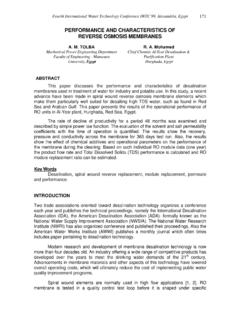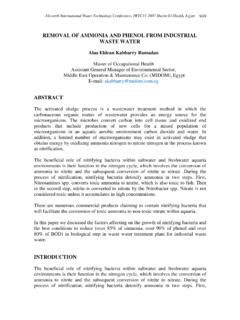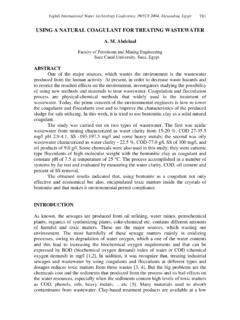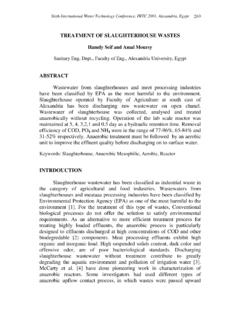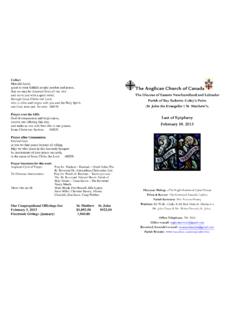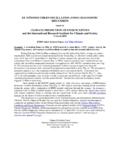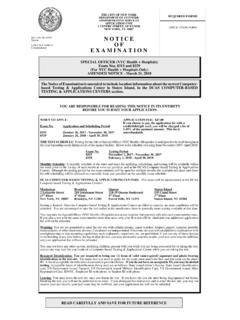Transcription of CROP WATER AND IRRIGATION WATER …
1 Tenth International WATER Technology Conference, IWTC10 2006, Alexandria, Egypt 781 CROP WATER AND IRRIGATION WATER requirements OF maize (ZEA MAYS L.) IN THE ENTISOLS OF KUWAIT M. Abdul Salam a and Suad Al Mazrooei b a Department of Biological Sciences, College of Science, Kuwait University, PO Box 5969, Safat 13060, State of Kuwait E-mail: b Department of Biological Sciences, College of Science, Kuwait University, PO Box 5969, Safat 13060, State of Kuwait E-mail: ABSTRACT Crop WATER and IRRIGATION WATER requirements of maize were estimated using the FAO CROPWAT model for the loamy sands of Kuwait. Agro-meteorological data 0f 43 years was used for this purpose. The crop WATER requirement (ETc), IRRIGATION requirement (IR) and net IRRIGATION requirement (NIR) of maize vary with the planting date.
2 WATER use of grain maize was the lowest with planting date of 5th November. The period 25th October to 5th December is suitable for maize planting. The ETc of grain maize varied from 210 mm for a 90 day crop to 273 mm for a 110 day crop with planting date 5th November. The IR of grain maize varied from 126 mm for a 90 day crop to 179 mm for a 110 day crop with same planting date. The NIR varied from 1226 m3 ha-1 for a 90 day crop to 1898 m3 ha-1 for 110 day crop with planting date 5th November. Grain maize planting may not be advanced beyond 5th December, in order to economise the WATER use. WATER use of sweet corn (60 days) was the lowest with planting date of 5th December. The period 5th November to 15th December is suitable for sweet corn planting.
3 ETc of sweet corn ranged from 125 mm (5th December planting) to 182 mm (15th October planting). The IR of sweet corn, ranged from 66mm (5th December planting) to 148 mm (15th October planting). The NIR of sweet corn was 532 m3 ha-1 with planting date 5th December. Sweet corn planting may not be advanced beyond 15th December, in order to economise the WATER use. An IRRIGATION schedule was also developed for grain maize and sweet corn for the loamy sands of Kuwait. Keywords: ETc, IRRIGATION , maize , sandy loam soils, WATER requirements INTRODUCTION Kuwait (located at 30o 27 N, 48 o 46 E) is one of the smallest countries of the Middle East. Soils are mostly entisols with low WATER -holding capacity and susceptibility to wind erosion.
4 The clay and organic matter content is low indicating poor soil fertility. Tenth International WATER Technology Conference, IWTC10 2006, Alexandria, Egypt 782 Calcareous nature in some areas and salinity problems in certain other areas pose problems for agricultural use. Kuwait Institute of Scientific Research (KISR), after a detailed soil survey reported that percent of the total land area is suitable for agriculture and are located at Al Wafra, Al Abdali and along the western margin of Kuwait City (KISR, 1999). Not much work has been done in Kuwait to develop agricultural production technologies. With the beginning of agricultural practices, growers look for scientific aspects of crop production including IRRIGATION .
5 Date palm, potato, barley and maize forms the most important crops grown under open field conditions under IRRIGATION . Being an extremely dry environment with harsh climate and poor soils, agriculture without IRRIGATION is rather impossible. WATER use efficiency in irrigated agriculture assumes greater significance particularly in semi arid environments with increasing pressure on WATER resources from competitive users (Hatfield et al., 1996). Information on scientific IRRIGATION scheduling is meager for crops of Kuwait. Indirect methods using evapotranspiration measurements are widely used to develop IRRIGATION schedules in many countries. Reference crop evapotranspiration (ETo) is evapotranspiration rate from a reference surface, not short of WATER .
6 It expresses the evaporating power of the atmosphere at a specific location and time of the year and does not consider the crop characteristics and soil factors. Reference crop evapotranspiration is also known as potential evapotranspiration (ETo) ( ). Evaporation and transpiration of a crop can be related to the ETo of the area as it is independent of factors other than climate. As such the information on ETo of an area will be a very useful guide for development of IRRIGATION schedules for crops. There are different approaches in developing IRRIGATION schedule. One method is the WATER balance or soil WATER budget approach which involves keeping an account of WATER input into the soil (rainfall and IRRIGATION ) and WATER output (evapotranspiration and drainage) on daily basis.
7 Measurements of rainfall and IRRIGATION may be easy but estimation of ET and drainage involves complex procedures. In many parts of the world, IRRIGATION is scheduled by use of a class A evaporation pan (Doorenbos, 1976). This is a (4 ft) diameter circular pan filled with WATER . The daily rate of evaporation from the pan is determined from the change in WATER level adjusted for rainfall. But the pan evaporation may be 25 to 100 percent more than ETo depending on location of the pan and the weather conditions. The important weather data required for the estimation of (ETo) are air temperature, humidity, wind speed and sunshine hours. A computer program (Hess, 1996) or a spread sheet (Hess and Stephens, 1993) can be used to calculate ETo using the Penman or Penman-Monteith equation.
8 This method has been shown to be reliable in a wide range of environments (Allen et al., 1994). Most WATER balance IRRIGATION schedule methods are based on a daily estimate of the reference evapotranspiration (ETo) which is then modified according to the type of crop, stages of growth and soil WATER content (Hess, 1996). He further reported that Penman-Monteith equation should give the best estimate of ETo where daily weather Tenth International WATER Technology Conference, IWTC10 2006, Alexandria, Egypt 783 data are available. Allen (1998) reports guidelines for computing crop WATER requirements based on evapotranspiration. Though several models have been proposed to predict ETo, there is no universal consensus on the suitability of any given model for a given climate, there by prompting (Smith et al.)
9 , 1996) to conclude that these models require rigorous local calibration before they can be used for the estimation of ETo for IRRIGATION scheduling. The local calibration and validation are more important in semi-arid environment than temperate, because almost all the ETo models were developed, calibrated, and validated for temperate environment using reliable and long term weather data (Ventura et al., 1999, Allen et al., 1998, Smith et al., 1996 and Jensen et al., 1990). For local calibration, the methodology published first in 1974 as Bulletin in the FAO (fao-24) IRRIGATION and Drainage series and revised in 1977 (Doorenbos and Pruitt, 1977), is widely followed internationally. Penman model frequently overestimated ETo, while the other models showed variable adherence to grass reference.
10 Further, the FAO-24 method assessed for a humid temperate environment in Tottori, Japan (Yano and Hayashi, 1977), using long-term weather data (1952-1974), indicated that Penman and Radiation balance models produced similar ETo estimates.. Recent studies have raised few concerns about the FAO-24 methodology (Jensen et al., 1990, Allen et al., 1989, Batchelor, 1984). The ETo estimates obtained from six commonly used ETo estimation models indicates that Penman-Monteith method produced the most reliable estimates, compared to lysimeter data, for the semi-arid Karaj region, in Iran (Hossein et al., 2004). Spatial distribution of potential evapotranspiration in the Indus river basin of Pakistan was estimated by Ullah et al.
